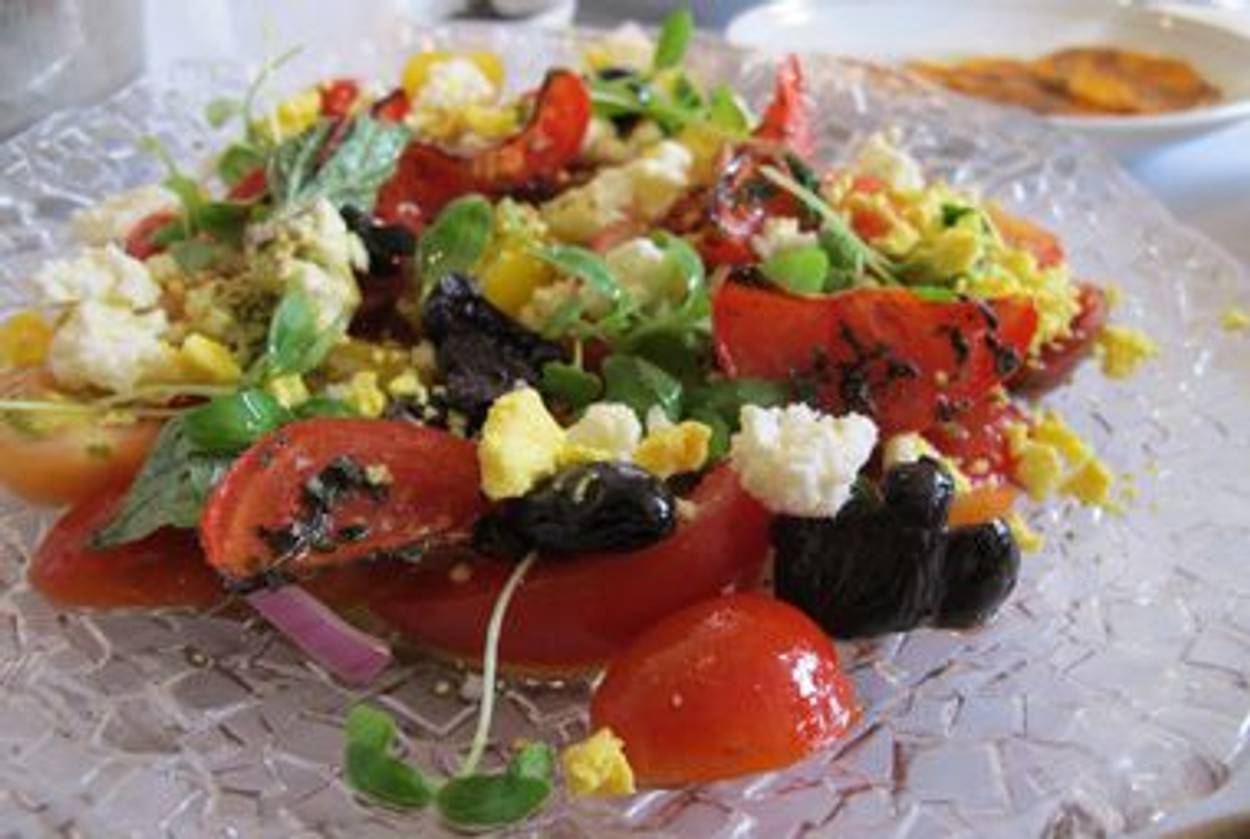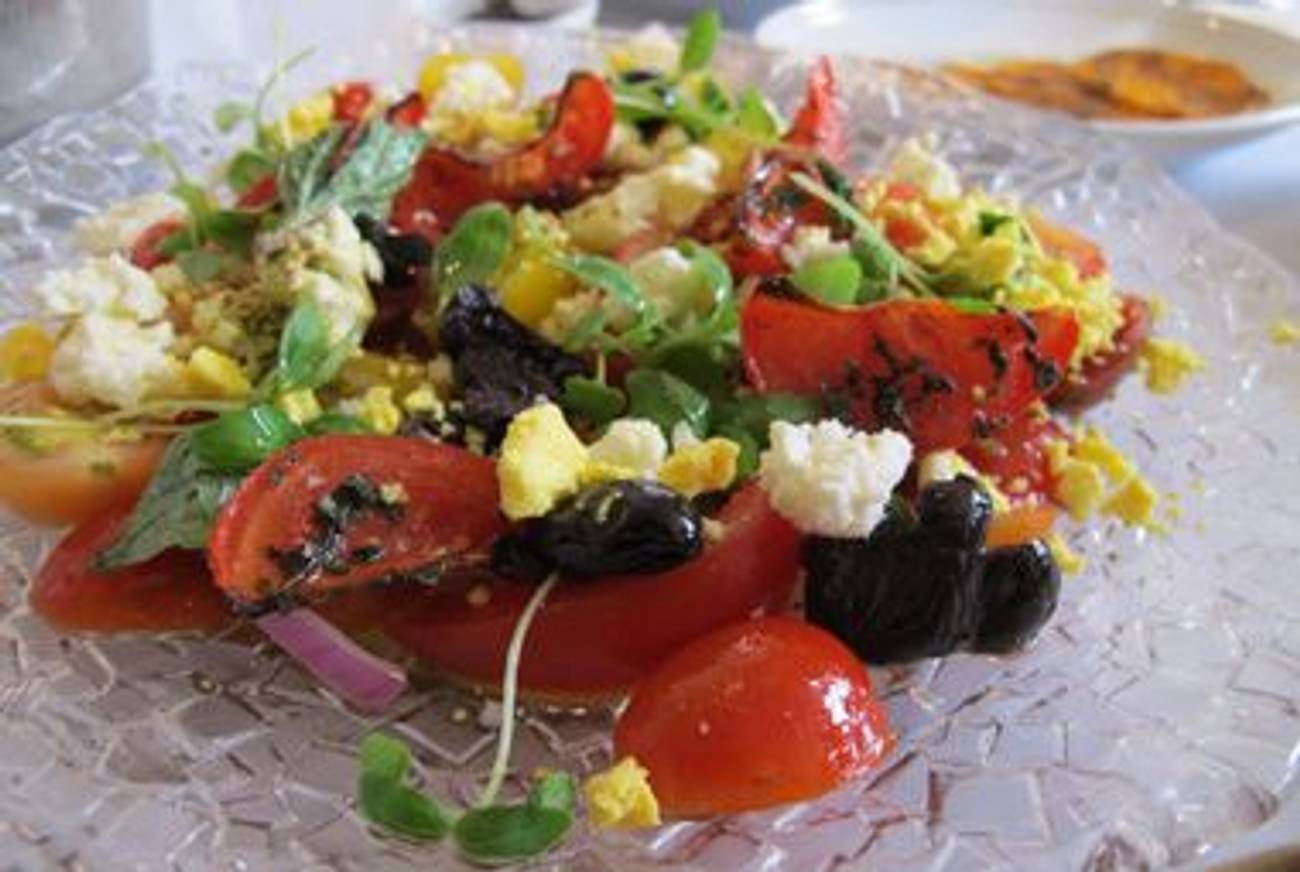Seeing Red
For some people, the best thing about summer is the tomatoes




In the heat of summer, nothing beats a really fresh tomato. As I sit at my desk on Martha’s Vineyard, I take frequent breaks to go to the deck to pluck a potted Sun Gold and pop it into my mouth. It is a mid-summer treat that I dream of as I pass by grocery store wannabes during the rest of the year. These pomodori, or golden apples, taste so sweet, so bright, that in the winter I refuse most impostors and can only stomach grape tomatoes, native to Southeast Asia and grown in California and Mexico, and canned San Marzanos.
With such a captivating flavor it seems unbelievable that after Cortéz brought tomatoes to Europe from Peru, Ecuador, and Mexico in the 16th century it took an additional 300 years for them to become popular, while other non-native foods like potatoes and peppers brought to Europe by Sephardic merchants traveling in the Americas caught on much faster.
In his excellent new book Pomodoro!: A History of the Tomato in Italy, David Gentilcore explains that it was only in the late 1800s that people began eating tomato sauce with spaghetti. Until then, if Italians ate tomatoes, they ate them three ways: cooked in a stew with other vegetables, similar to ratatouille or caponata; as a sauce like shakshuka, or concentrate; or, as an added ingredient to meat stews. Rarely, if ever, did people eat tomatoes raw.
The reasons for this delayed popularity are wide ranging. This member of the nightshade family was once considered poisonous. When the acid of the tomato hit the pewter flatware and plates used by the well-to-do, it reacted with the lead in such kitchenware, sickening people. Tomatoes were thought to contain toxins and/or hallucinogenic compounds. They were called “wolf peaches” in Germany, where folklore held that witches used the tomato’s juices to lure werewolves. The British employed tomatoes as ornamental plants, not as food. Jews in Eastern Europe associated tomatoes with blood because of their color. Since blood is taboo in Jewish cooking, Jews either avoided eating tomatoes, called the pomme d’amour, or love apple, by the French, or cooked them to death, as they did meat. My mother-in-law, who came from the town of Zamosc in Poland, refused to eat tomatoes until she immigrated to the United States after World War II and was convinced by their popularity here to give them a second chance .
Thomas Jefferson, an avid gardener at his home at Monticello, credited Dr. John de Sequeyra (pronounced “Siccary”), a Sephardic doctor in Colonial Williamsburg, as the first person to introduce the tomato as a plant in Virginia. The doctor believed that daily consumption of the tomato not only maintained good health but prolonged life. At the time, he was taking care of Jefferson’s father. According to an account by Robert Shosteck in the American Jewish Archives, Jefferson created some commotion in the late 1700s when he made a display of eating a tomato in public in Lynchburg. The crowd held their breath to see what effect the food would have. Jefferson lived, and soon thereafter, with de Sequeyra’s blessing, and that of other doctors who had been testing the tomato, people in the United States began to embrace and incorporate tomatoes into their cooking.
The Israeli author Shmuel Yosef Agnon came to Palestine from Galicia in 1908. In his slightly autobiographic novel, T’Mol Shilshom (Only Yesterday), set in Palestine, the main character, Itzhak, experiences culinary culture shock. As part of his adjustment to a new country, Itzhak must learn to eat its staples—olives and tomatoes.
“Itzhak did not know tomatoes are a food for humans, for in his town [in Galicia] people used to call tomatoes ‘foolish apple’ and clever people would avoid them,” Agnon wrote. “All of a sudden, hunger came and told him—eat! He took a piece of bread and a few olives, one of the seven species with which the land of Israel is blessed, but could not touch a tomato. When he tasted the olives, he distorted his face in dislike. When his host saw him he smiled and said ‘Just as you distorted your face from them today, so you will be happy for them tomorrow because you will be so hungry … there is nothing else to eat. Take a tomato and eat.’ After Itzhak ate a slice of tomato, he could not continue. He thought, ‘I will have none of your sweet and none of your sour acid.’ His friend responded, ‘If you want to be a son of the land of Israel, you must eat whatever you find.’ ” And so Itzhak, and immigrants like Agnon, became accustomed to the tomato, often cooked with fried eggplant or with olives.
Today, only a century later, we no longer hold any fears of this refreshing fruit. We recognize several kinds of heirlooms, those in existence for 50 years or more, and often disdain hothouse tomatoes or impure hybrids. In another new book on the subject, Ripe: The Search for the Perfect Tomato, Arthur Allen explains what heritage tomatoes, or heirlooms, are and introduces the reader to people like Sandra Bellin and Larry Jacobs, former Peace Corps volunteers, who grow extraordinary organic tomatoes at their Del Cabo Farms in Baja, Mexico. “First impressions are as important in taste as they are in love,” Allen wrote after biting into one of their Golden Honeybunch. “Tomato flavor is complex, fleeting, impossible to describe. For all that, I’ll be damned if those weren’t the best tomatoes I’ve ever tasted.” But Allen and others wrestle with a bigger problem. If they are so delicious, how can we get them to consumers hundreds of miles away without leaving a huge carbon footprint? That is the question and the ultimate problem of finding the perfect tomato in America, four centuries after they were first discovered.
HERBERT SAMUEL’S TOMATO SALAD
Adapted from Chef Jonathan Roshfeld
6 medium tomatoes, cut in quarters
1 pint mixed red and yellow cherry tomatoes, halved
2 mini tiger heritage tomatoes, halved
20 black olives, pitted and halved
6 radishes, thinly sliced
½ chili pepper, thinly sliced
½ red onion, thinly sliced
6 teaspoons scallions, diced
10 basil leaves, cut in chiffonade
2 teaspoons oregano leaves
3 teaspoons of fresh thyme leaves
1 cup pea shoots or other greens
3 egg yolks, cooked and crushed
4 ounces feta or goat cheese
Juice of 1 lemon, or to taste
4 tablespoons olive oil
Sea salt to taste
1. Place the quartered tomatoes over the gas burner or the grill to slightly char the outside. After charred and cooled, cut them into pie-shaped pieces.
2. Put these with the remaining cut tomatoes in a large bowl. Add the olives, radishes, chili pepper, red onion, scallions, basil, oregano, thyme, pea shoot or other greens, the egg yolks, and the goat cheese.
3. Drizzle the lemon juice over all ingredients and then sprinkle with the olive oil. Add salt to taste and gently toss. Serve on individual plates for a refreshing and delicious first course.
Yield: 6 to 8 servings
RATATOUILLE OF ZUCCHINI, TOMATOES, EGGPLANT, AND PEPPERS
Adapted from the forthcoming Quiches, Kugels and Couscous: My Search for Jewish Cooking in France by Joan Nathan
¼ cup olive oil
5 medium yellow onions, cut into ½ inch pieces
5 cloves garlic, peeled and minced
2 teaspoons salt
4 small zucchini, cut into ½-inch pieces (about 2 pounds)
Freshly ground pepper to taste
1 red bell pepper, cut into ½-inch pieces
1 green bell pepper, cut into ½-inch pieces
2 pounds eggplant, preferably small ones, cut into ½-inch pieces
2 pounds tomatoes, cut into ½-inch pieces
4 teaspoons sugar
1 teaspoon piment d’Espelette, hot paprika, or New Mexican ground red chili
1. Preheat the oven to 325 degrees.
2. Heat the olive oil in a large skillet. Add the onions, the garlic, and the salt, and cook over medium-high heat until the onions are just translucent, about five to seven minutes. Remove three quarters of the onions to a bowl. Add the zucchini to the pan with the remaining quarter of the onions, season with a little salt and freshly ground pepper to taste, and cook for a few minutes until the zucchini begin to brown. Transfer the zucchini and onion mixture to an 8-inch square or circular baking pan.
3. Sauté the green and red peppers separately just until they begin to brown, with a third of the remaining onions, then the eggplant with another third of the onions, and then the tomatoes with the remaining onions. Transfer each vegetable to its own baking pan.
4. Cover the four pans with aluminum foil, and bake in the preheated oven for 1 hour. Uncover the pans, sprinkle each with a teaspoon of the sugar and hot pepper, and stir. Cook for an additional hour uncovered. If there is any liquid in the pans after the second hour, drain the vegetables and reserve that liquid. Gently toss the vegetables together.
5. Place the reserved liquid in a small saucepan, bring to a boil, and reduce until it is thick and can coat the back of a wooden spoon. Stir this reduction into the ratatouille. Taste and adjust the seasoning if necessary. Serve at room temperature.
Yield: 8 to 10 servings
Joan Nathan is Tablet Magazine’s food columnist and the author of 10 cookbooks including King Solomon’s Table: a Culinary Exploration of Jewish Cooking from Around the World.